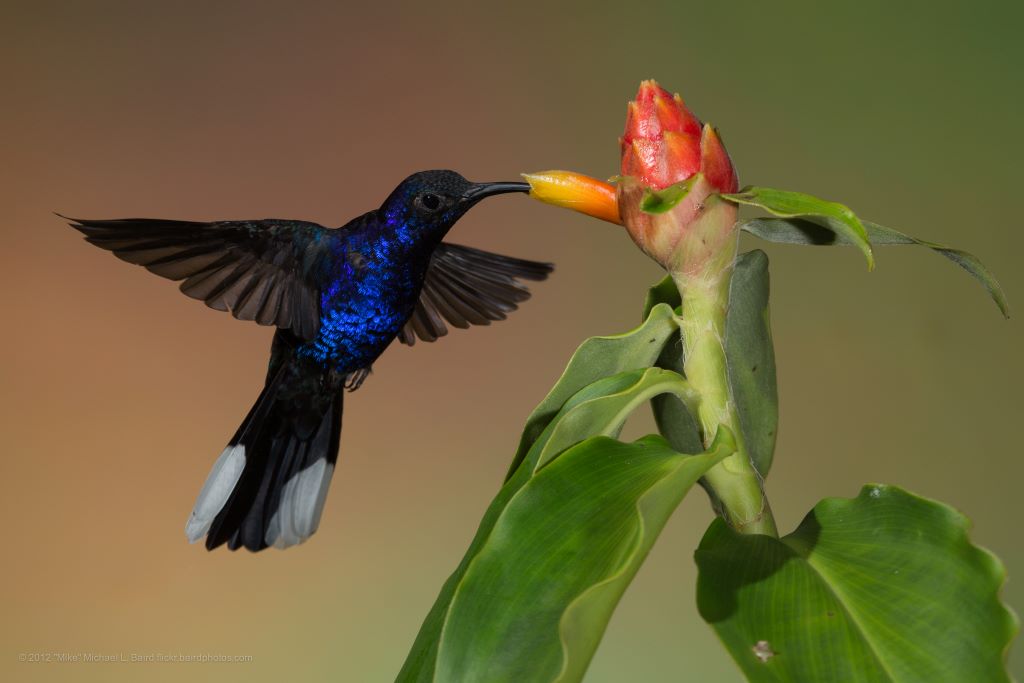
East of the Mississippi there is one species of hummingbird. West of the Mississippi you may find six or seven species of hummers. It takes a bit of knowledge to tell them apart, especially the females and immatures. That challenge pales in comparison to trying to identify hummingbirds apart in Colombia, which has over 300 species! I haven’t been to Colombia, but I have been to Peru, Chile, Argentina, and Costa Rica, and was nearly overwhelmed by the choices in my field guides.
Hummingbirds are unusual in several ways. Their wings swivel back and forth through the air, similar to our arm movements when treading water, allowing them to hover and fly backwards, nearly unique in the bird world. Their bills have evolved to reach nectar sources of flowers. Tropical hummingbird bills can be curved or straight and even longer than the bird’s body! To drink nectar, they don’t slurp it through their bill like a straw. The tongue, with many fine projections that absorb the sugar solution, is drawn up into the bill and squeezed out. I mentioned earlier that, if you feed hummingbirds, a 5:1 sugar solution is fine. Some recommend 4:1 but sugar may crystallize on the bill and cause infection and kill the bird, so 5:1 is safer. You can feed them as late in the year as you want; feeding them will not prevent their migration. Red food coloring is not known to cause any health problems for the birds but there is no need to color the sugar water in your feeder; they will find it anyway, but some red color on the feeder is helpful.
The iridescent color on many hummingbirds, like the head and throat of Anna’s, is due to a combination of pigments and feather structure. If you watch a mature male as it twists and turns its head, the head will appear bright red one moment, purple the next, and then black. Tiny bubbles inside the feather barbs refract and reflect light in different ways, resulting in iridescence and varying colors.
The territorial behavior and aggressiveness of hummingbirds is well known to anyone who has watched a hummingbird feeder. Why are these little birds so assertive? Simply because, in nature, nectar sources are ephemeral – they are only available for only a few hours in each flower and the bird needs to get to them quickly and ward off competitors. I have a friend and colleague who researches flower blooming and hummingbird territories. In one experiment in Yosemite Park, he and his graduate students unloaded 500 pots of flowers from a truck and placed them in a large plot on the ground. Within five minutes, several hummingbirds were establishing territories around the flowers that were producing nectar!
Finally, the scientific name of the hummingbird order, which includes the swifts, is Apodiformes, which means “without feet”, because early observers thought these very aerial birds were unable to perch due to a lack of feet! (And, as the old story goes, hummingbirds hum because…. they don’t know the words!) For detailed information on hummingbirds, go to http://www.hummingbirds.net/ .
This appears to be a Photoshopped picture combining two hummingbird species: the tufted coquette, and the streamertail. Judging by my (admittedly quick) Google image search, the picture originates from http://dwarf4r.deviantart.com/gallery/ I’m certainly no expert on hummingbirds, I’ve only looked at a lot of photos, and of course I’ve seen the local ruby-throated hummingbirds. Let me know if I’m mistaken.
I am sure you are correct – wondered why I had so much trouble with it. Got fooled once before by a real bird I thought was fake. Darned photoshop
Please identify the bird shown above. I use it as a wallpaper and have searched endlessly without luck to discover its name and origin. THANK YOU!!
I apparently got fooled by a photoshopped picture – see following comment